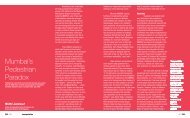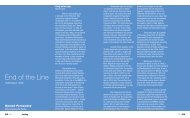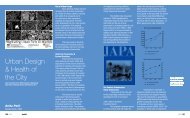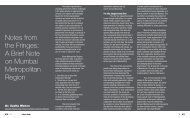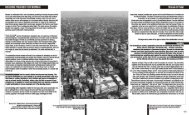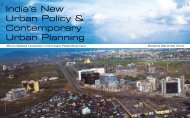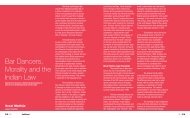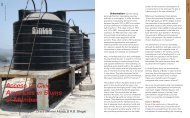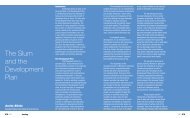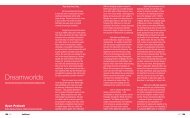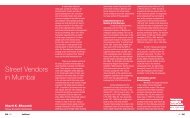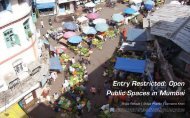Homeless in Neoliberal Cities: View from Mumbai - Urban Design ...
Homeless in Neoliberal Cities: View from Mumbai - Urban Design ...
Homeless in Neoliberal Cities: View from Mumbai - Urban Design ...
Create successful ePaper yourself
Turn your PDF publications into a flip-book with our unique Google optimized e-Paper software.
of land <strong>in</strong> cities like <strong>Mumbai</strong> offer<strong>in</strong>g<br />
shelter to nearly 60 per cent of the<br />
city’s population. This means that the<br />
rema<strong>in</strong><strong>in</strong>g 94 per cent of the land is<br />
used by 40 per cent of the residents.<br />
Exclud<strong>in</strong>g the slum dwellers and people<br />
liv<strong>in</strong>g <strong>in</strong> impermanent tenements,<br />
the homeless <strong>in</strong> <strong>Mumbai</strong> number<br />
around 1,00,000 (Iyer, 2005). In official<br />
documents and <strong>in</strong> the psychological<br />
doma<strong>in</strong> of the affluent, they are often<br />
considered as encroachers on public<br />
land with their citizenship constantly<br />
be<strong>in</strong>g debated <strong>in</strong> various platforms.<br />
Although no exhaustive study<br />
exists on the homeless population <strong>in</strong><br />
<strong>Mumbai</strong>, the few studies and surveys<br />
that have been conducted by NGOs and<br />
researchers <strong>in</strong> different parts of the city<br />
do throw light on the overall hapless<br />
situation of the homeless <strong>in</strong> this budd<strong>in</strong>g<br />
<strong>in</strong>ternational f<strong>in</strong>ancial centre of India. A<br />
sample survey carried out <strong>in</strong> recent past<br />
by the Action-Aid <strong>in</strong> six zones (subdivided<br />
<strong>in</strong>to 24 wards) of the metropolis reveals<br />
that the largest concentration of the<br />
homeless is found <strong>in</strong> Zone 1 i.e. <strong>in</strong> the<br />
five (A,B,C,D,E) wards located <strong>in</strong> the<br />
southern parts of <strong>Mumbai</strong>, spread<strong>in</strong>g<br />
<strong>from</strong> Colaba <strong>in</strong> the south to Kamathipura,<br />
<strong>Mumbai</strong> Central and Byculla <strong>in</strong> the north.<br />
Accord<strong>in</strong>g to this report, the <strong>in</strong>tensity of<br />
the homeless population decl<strong>in</strong>es <strong>from</strong> the<br />
south to the north. Among the homeless,<br />
the overall number of males is more than<br />
the females, although <strong>in</strong> certa<strong>in</strong> areas of<br />
the E ward (near Reay Road Station) the<br />
number of males and females match each<br />
other. In general, a typical sociological<br />
character is seen to exist among the<br />
sample households, i.e. socially deviant<br />
behaviours like drug addiction is found<br />
rampant <strong>in</strong> areas where males are larger<br />
<strong>in</strong> number than females (Action-Aid,<br />
n.d.). The survey further reveals that 75<br />
per cent of the sample population is <strong>in</strong><br />
the age group of 16-45 years <strong>in</strong>dicat<strong>in</strong>g<br />
a concentration of adult population of<br />
work<strong>in</strong>g age group whose contribution<br />
to the urban economy is unquestionable.<br />
The survey report is critical about the<br />
statist perspective that considers the<br />
homeless generally as beggars who<br />
have noth<strong>in</strong>g but a parasitical existence<br />
<strong>in</strong> the city. The survey further reveals<br />
that 60 per cent of the homeless are<br />
illiterate that speaks of their abject<br />
poverty that acts as a serious constra<strong>in</strong>t<br />
<strong>in</strong> access<strong>in</strong>g education. All these facts<br />
are substantiated by an exhaustive<br />
research undertaken by Menezes (2010)<br />
on rag pickers (who constitute a sizeable<br />
proportion of the homeless) <strong>in</strong> <strong>Mumbai</strong>.<br />
Out of his total sample population, 85 per<br />
cent of the adults are illiterate while the<br />
illiterate children constitute 91 per cent<br />
of the total. They do not have access to<br />
basic services like water, sanitation or<br />
electricity. Almost as a rule, they do not<br />
have ration cards (effectively considered<br />
as identity cards to live, work and study<br />
<strong>in</strong> <strong>Mumbai</strong>). Systematically they rema<strong>in</strong><br />
excluded <strong>from</strong> any k<strong>in</strong>d of public policy<br />
that concerns the progress of the city.<br />
The above study on the rag<br />
pickers br<strong>in</strong>gs out the realities of the life<br />
and work pattern of a huge section of the<br />
homeless <strong>in</strong> <strong>Mumbai</strong>. The study, based<br />
on an extensive survey <strong>in</strong>volv<strong>in</strong>g 700<br />
rag pickers as respondents (<strong>in</strong>clud<strong>in</strong>g 50<br />
child rag pickers), critically analyses the<br />
socio-spatial status of the homeless <strong>in</strong> a<br />
globalis<strong>in</strong>g city. The survey was conducted<br />
<strong>in</strong> different parts of the metropolis <strong>from</strong><br />
the southernmost areas of Colaba to<br />
Andheri and Vikhroli <strong>in</strong> the north and<br />
Mankhurd <strong>in</strong> the east, cover<strong>in</strong>g extensive<br />
areas <strong>in</strong> eastern and western suburbs. The<br />
situation and status of the <strong>in</strong>terviewed<br />
rag pickers can thus be said to form a<br />
consolidated narrative of the homeless<br />
<strong>in</strong> the city, part of which has been<br />
discussed <strong>in</strong> the follow<strong>in</strong>g paragraphs.<br />
Socio-economic Status of<br />
Rag Pickers <strong>in</strong> <strong>Mumbai</strong><br />
Rag pickers <strong>in</strong> <strong>Mumbai</strong> are<br />
one of the most vulnerable sections<br />
of the homeless population of the<br />
city. They usually live on self-made<br />
impermanent shacks on pavements<br />
or on bare open spaces. Constantly<br />
harassed by civic authorities, municipal<br />
officials and workers, police, at times<br />
private security agents, they rarely<br />
have access to any k<strong>in</strong>d of protective<br />
mechanism. It goes without say<strong>in</strong>g that<br />
<strong>in</strong> an <strong>in</strong>tense neoliberal scenario, with<br />
the urban plann<strong>in</strong>g policies becom<strong>in</strong>g<br />
even more cost effective, the possibility<br />
of <strong>in</strong>tegrat<strong>in</strong>g such poor groups <strong>in</strong> the<br />
city’s development programmes looks<br />
bleaker. Even though the websites of the<br />
JNNURM are flooded with <strong>in</strong>formation<br />
on water supply, sanitation and BUSP<br />
projects for the poor, one wonders why<br />
then the cases of evictions, demolitions<br />
and unlawful slum acquisitions for mak<strong>in</strong>g<br />
way for mega commercial projects<br />
have reached an all-time high. In many<br />
cases these are blatantly done aga<strong>in</strong>st<br />
the exist<strong>in</strong>g City Development Plan.<br />
For example, the Atria Shopp<strong>in</strong>g Mall<br />
at Worli has been built on a three acre<br />
municipal land which accord<strong>in</strong>g to the<br />
exist<strong>in</strong>g City Development Plan, was kept<br />
reserved for hous<strong>in</strong>g the homeless and<br />
for a municipal primary school (obviously<br />
meant for the children of the poor).<br />
Instead of the school and the planned<br />
1885 tenements, the land now houses the<br />
sprawl<strong>in</strong>g mall, violat<strong>in</strong>g the provision of<br />
the Plan (NAPM, 2010). Com<strong>in</strong>g back to<br />
the rag pickers, while their contribution<br />
towards the waste management system<br />
of the metropolis is unquestionable, they<br />
themselves are denied any k<strong>in</strong>d of clean<br />
environment <strong>in</strong> the city (Menezes, 2010).<br />
1. Liv<strong>in</strong>g Space: Rag pickers can only<br />
have access to <strong>in</strong>formal hous<strong>in</strong>g which<br />
accord<strong>in</strong>g to the 2001 Census, are poorly<br />
built impermanent structures, located <strong>in</strong><br />
congested and unhygienic environments<br />
without any provision of <strong>in</strong>frastructure<br />
<strong>in</strong> terms of water supply, sanitation and<br />
dra<strong>in</strong>age. In <strong>Mumbai</strong>, they are seen <strong>in</strong><br />
ubiquitous locations, along railway tracks,<br />
along roads that are seldom used, <strong>in</strong>side<br />
unused storm water pipes, beside water<br />
pipel<strong>in</strong>es, underneath the flyovers, on<br />
ill-dra<strong>in</strong>ed marshlands or vacant lands<br />
(Menezes, 2010). A few are found to<br />
live <strong>in</strong> shacks made on pavements, or<br />
marshy land, e.g. near Sion Station or<br />
Mankhurd. The same story gets repeated<br />
<strong>from</strong> one city to the other. 62 per cent of<br />
the sample households <strong>in</strong> the study have<br />
a per capita liv<strong>in</strong>g space of 30 sq. ft.<br />
Like the homeless <strong>in</strong> other<br />
cities, a large number of the homeless<br />
<strong>in</strong> <strong>Mumbai</strong> too live <strong>in</strong> the open, under<br />
trees, <strong>in</strong> desolate corners of parks,<br />
anywhere they can (Sharma, 2000),<br />
without hav<strong>in</strong>g any impermanent shelter<br />
made. Be<strong>in</strong>g forced to use the public<br />
space for their private use, they do<br />
not have a semblance of hav<strong>in</strong>g any<br />
residential space of any sort. A large<br />
section of the urban homeless develop<br />
a nomadic nature. This is because they<br />
live under a constant threat of eviction.<br />
Rag pickers largely belong to this group.<br />
068 / 03 hous<strong>in</strong>g<br />
03 / 069



